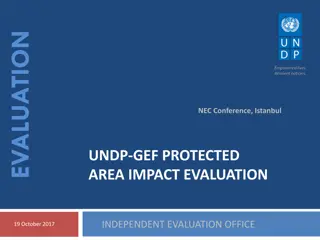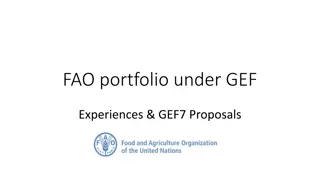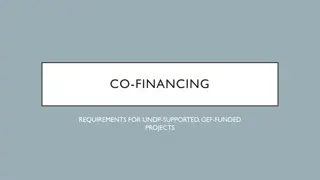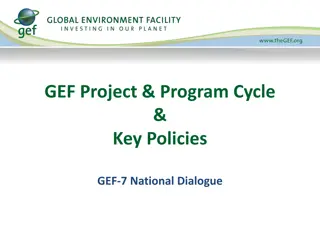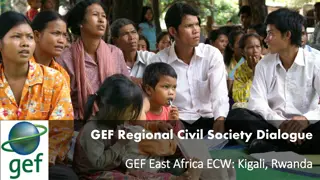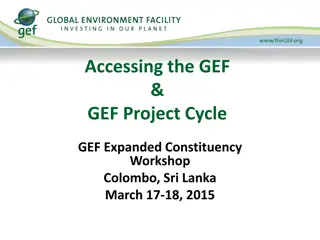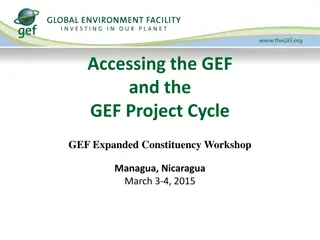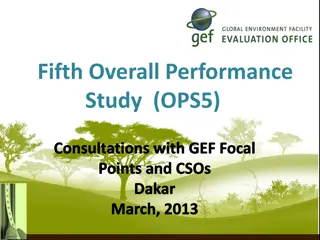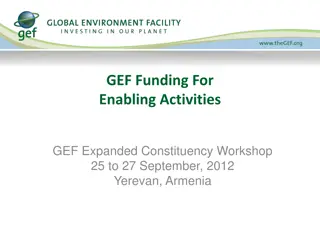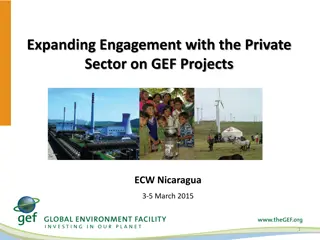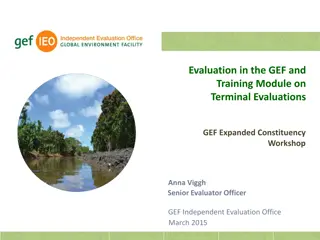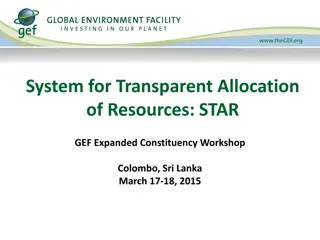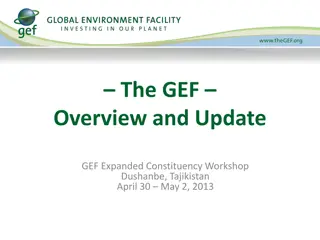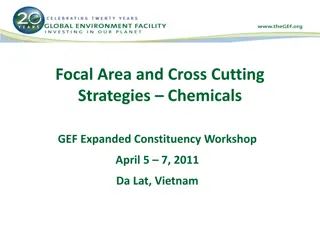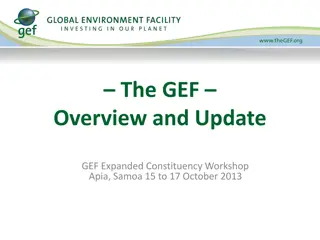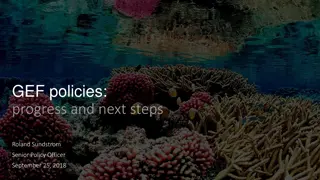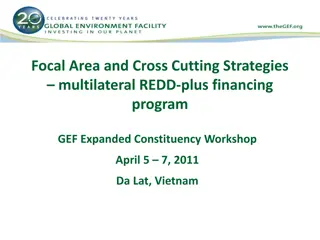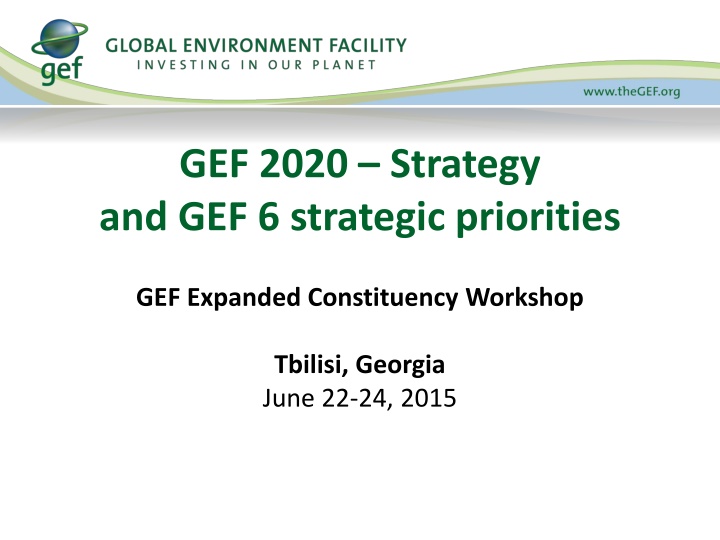
GEF 2020 Strategy and Environmental Solutions Overview
Explore the GEF 2020 Strategy focusing on addressing environmental degradation, delivering integrated solutions, and enhancing resilience. Key areas include drivers of environmental degradation, sustainable cities, resilience programs, and more. Learn about GEF's initiatives to combat pressing environmental challenges and achieve a sustainable future.
Download Presentation

Please find below an Image/Link to download the presentation.
The content on the website is provided AS IS for your information and personal use only. It may not be sold, licensed, or shared on other websites without obtaining consent from the author. If you encounter any issues during the download, it is possible that the publisher has removed the file from their server.
You are allowed to download the files provided on this website for personal or commercial use, subject to the condition that they are used lawfully. All files are the property of their respective owners.
The content on the website is provided AS IS for your information and personal use only. It may not be sold, licensed, or shared on other websites without obtaining consent from the author.
E N D
Presentation Transcript
GEF 2020 Strategy and GEF 6 strategic priorities GEF Expanded Constituency Workshop Tbilisi, Georgia June 22-24, 2015
Key Earth systems are near or beyond tipping points Not yet quantified Planetary boundaries have been crossed or nearly crossed Proposed safe operating space for humanity in planetary systems Source: Rockstrom et al, A Safe Operating Space for Humanity, Nature (2009)
GEF2020 Strategy A new strategy aimed at making the GEF an even more centralized actor in the international environmental arena and at achieving impacts at the scale Outline of GEF2020 Strategy Focus on drivers of environmental degradation Deliver integrated solutions, given that many global challenges are interlinked Enhance resilience and adaptation Ensure complementarity and synergies in climate finance Choose the right influencing model
1. Address Drivers of Environmental Degradation Indirect environmental drivers drivers trends Underlying socioeconomic Direct environmental Environmental pressures Changes in state of environment Agriculture production processes that produce food Demand for food production Atmosphere (climate) Pollution e.g., GHG s & ozone- depleting substances Population growth Biodiversity Demand for buildings Change in habitat and species loss Provision/use of transportation Demand for energy Rising middle class Land Construction & use of buildings & other infrastructure Introduction of invasive species Demand for transportation Oceans Production of electricity Over exploitation and harvesting Urbanization Other Other Other Freshwater Pressure interventions Driver interventions Changes in human welfare
2. Deliver Integrated Solutions Ex: Integrated approach programs (IAPs) in GEF-6: Sustainable Cities Deforestation out of Commodity Supply Fostering Sustainability and Resilience for Food Security in Sub-Saharan Africa An increasing portfolio of multi-focal area projects and programs
3. Enhance Resilience GEF Adaptation Program: LDCF, SCCF 124 countries worth US$1.2 billion National adaptation plans (NAPs) Ecosystem based adaptation
4. Ensure Complementarity in Climate Finance Increasingly complex climate finance architecture GEF niche : Transforming policy and regulatory environments; build institutional capacity Demonstrate new technology and business models De-risk partner investments Build multi-stakeholder alliances
Choosing the Right Influencing Model Transforming policy and regulatory environments Strengthening institutional capacity and decision-making processes Convening multi-stakeholder alliances. Demonstrating innovative approaches. Deploying innovative financial instruments
Three Key Operational Priorities Work closely with local and global stakeholders (national and local governments, private sector, civil society) Underpinned by Focal Area Strategies Improve GEF operational efficiencies Strengthen Results Management
Implementing GEF-6 GEF-6 operational July 1, 2014 - June 30, 2018 Donor countries pledged USD 4.43 billion, the record funding level Main changes from GEF-5: More for Chemical (Minamata); Less for Climate (GCF?); Biodiversity now largest FA Note: Excludes Corporate Programs and Non-Grant Instrument Pilot. Also, does not include LDCF/SCCF
Implementing GEF-6 Through strategic partnerships Address global environmental issues where a country plays a pivotal role Activities that cut across multiple focal areas and sectors, and promote integrated approach in achieving your national development objectives. Identify those areas in your National Plans where GEF can support policy, market or behavioral transformations. Combine GEF resources with other existing resources from other donors and the government, and thus leveraging the impact in advancing national environmental priorities
Implementing GEF-6 - Use of funds (recipient countries) GEF6 Allocations (US$mill) 700 631 1007 41 412 523 32 2338 COUNTRIES Share SIDS/LDCs "Big 5" 30% 27% 43% 2% 18% 22% 1% 100% Other Countries LICs LMICs UMICs HICs Of which TOTAL Country Allocations => Trade-off: Impact vs equity ?


